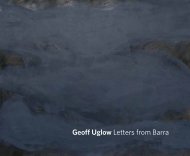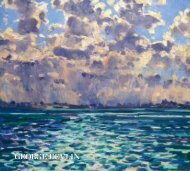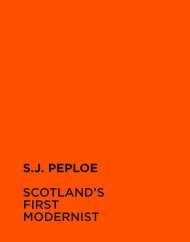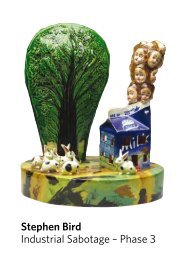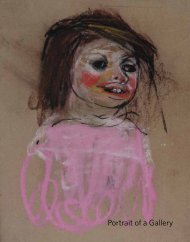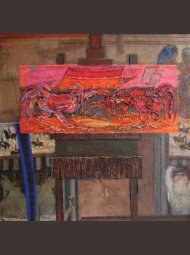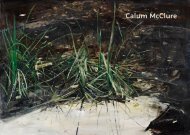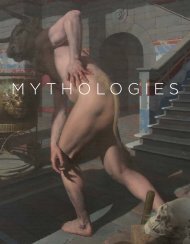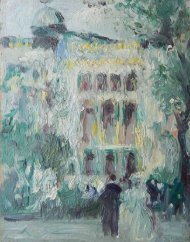Download a PDF of the exhibition catalogue - The Scottish Gallery
Download a PDF of the exhibition catalogue - The Scottish Gallery
Download a PDF of the exhibition catalogue - The Scottish Gallery
Create successful ePaper yourself
Turn your PDF publications into a flip-book with our unique Google optimized e-Paper software.
<strong>catalogue</strong><br />
Eugène Boudin was born in Normandy in 1824. He spent his childhood on <strong>the</strong> sea, working as <strong>the</strong> cabin boy on his<br />
fa<strong>the</strong>r’s cargo ship. This early exposure to <strong>the</strong> sea and skies <strong>of</strong> <strong>the</strong> French Coast was to form his primary focus as a painter<br />
later in life. It was Boudin who would form <strong>the</strong> all important link between traditional French landscape and <strong>the</strong> start <strong>of</strong><br />
<strong>the</strong> Impressionist movement.<br />
His early career consisted predominantly <strong>of</strong> painting outdoor sketches in <strong>the</strong> summer, which he would <strong>the</strong>n<br />
complete in his studio over <strong>the</strong> winter months. During this period he also painted genre scenes and still life but it<br />
was <strong>the</strong> vast skies and seas <strong>of</strong> <strong>the</strong> Normandy Coast that he always returned to. In 1862 he began to paint <strong>the</strong> crowds<br />
<strong>of</strong> fashionable tourists who flocked to <strong>the</strong> coast from Paris on summer weekends. To paint people on a beach, smartly<br />
dressed and enjoying <strong>the</strong>mselves was daringly modern. <strong>The</strong> Impressionists developed this subject in <strong>the</strong> coming decades,<br />
but it marked Boudin out as distinctly avant-garde. By <strong>the</strong> middle <strong>of</strong> <strong>the</strong> 1850s he recognized <strong>the</strong> ‘falseness’ <strong>of</strong> painting<br />
landscapes from memory and bean to paint almost exclusively en plein air a practice that was to be so influential on <strong>the</strong><br />
Impressionists. <strong>The</strong> immediacy <strong>of</strong> <strong>the</strong> work Boudin painted outdoors and <strong>the</strong> attention paid to <strong>the</strong> changing atmosphere<br />
had a particular effect on <strong>the</strong> young Claude Monet, who first worked alongside him in 1856. He said, ‘…it was as if a<br />
veil had been torn from my eyes. I had understood, had grasped what painting could be. Boudin’s absorption <strong>of</strong> his work,<br />
and his independence, were enough to decide <strong>the</strong> entire future and development <strong>of</strong> my painting.’ 1<br />
Although he had been exhibiting at <strong>the</strong> Paris Salon since 1959, he displayed little appetite for increasing his<br />
pr<strong>of</strong>ile and chose not to move to Paris permanently. By <strong>the</strong> late 1860’s he stopped painting <strong>the</strong> scenes <strong>of</strong> stylish figures<br />
on <strong>the</strong> beach, and dedicated himself entirely to his coastal scenes. Despite this, his reputation was such that in 1874 he<br />
was included in <strong>the</strong> first Impressionist <strong>exhibition</strong> and although he chose not to become part <strong>of</strong> <strong>the</strong> notorious group he<br />
still exhibited with many <strong>of</strong> <strong>the</strong> artists.<br />
Our painting depicts <strong>the</strong> mouth <strong>of</strong> <strong>the</strong> river Toques flanked by two jetties which form <strong>the</strong> entrance to Trouville<br />
harbour. It was a favourite subject for Boudin (ano<strong>the</strong>r version is in <strong>the</strong> National <strong>Gallery</strong> collection – <strong>The</strong> Entrance to<br />
Trouville Harbour, 1888 and was <strong>the</strong> first ‘modern’ French work to be acquired for <strong>the</strong> State). Boudin captures his scene<br />
on a blustery summer’s day. <strong>The</strong> tide is far out with <strong>the</strong> break water just visible on <strong>the</strong> horizon. <strong>The</strong> primary focus <strong>of</strong><br />
<strong>the</strong> painting is <strong>the</strong> fishing boat which rests, lazily on a sandbank. <strong>The</strong> immediacy and vibrancy with which he captures<br />
<strong>the</strong> effect <strong>of</strong> bright sunlight on <strong>the</strong> boat’s deck and rigging demonstrate <strong>the</strong> ideals which Impressionism was to take<br />
fur<strong>the</strong>r, all rendered with rapid, short brushstrokes. More boats rest against <strong>the</strong> jetty walls, while a local tries his luck<br />
at fishing on <strong>the</strong> left side <strong>of</strong> <strong>the</strong> river. Tourists with parasols amble on ei<strong>the</strong>r side <strong>of</strong> <strong>the</strong> harbour toward <strong>the</strong> two brilliant<br />
white lighthouses, all captured with quick, measured dabs <strong>of</strong> Boudin’s brush.<br />
Blyth acquired this and <strong>the</strong> following painting from <strong>The</strong> <strong>Scottish</strong> <strong>Gallery</strong> in 1943. Although Alexander Reid had<br />
introduced <strong>the</strong> Boudin to Scotland in <strong>the</strong> 1890s it seems that Blyth asked <strong>The</strong> <strong>Scottish</strong> <strong>Gallery</strong> to acquire <strong>the</strong>se works on<br />
his behalf. In <strong>the</strong> receipt it itemizes ‘packing’ and ‘forwarding’ <strong>of</strong> <strong>the</strong> pictures from London.<br />
1 G. Jean-Aubry & Robert Schmit, Eugène Boudin, (New York Graphic Society, Greenwhich, 1968), p.27<br />
24



